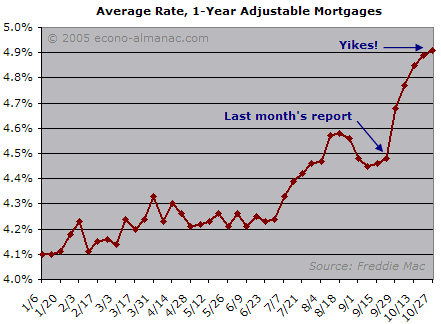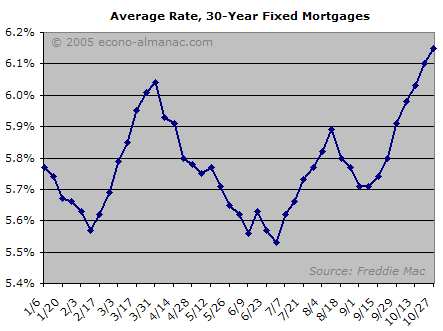You may recall from last month’s credit market report that I was expecting ARM rates to rise. But even I didn’t think they’d head so high, so fast. Read on for a look at the chart that should (but probably doesn’t) have the real estate bulls seriously concerned.
Short-Term Rates
Without further ado, let’s look at that chart:

I cannot emphasize the import of this chart enough. If ARM rates keep rising, or even stay at their current levels, then San Diego’s 10-year real estate party is over.
Why do ARM rates matter so much? Because 80% of all San Diego home purchases are made using ARMs instead of fixed-rate mortgages. Since July, the monthly payment on a given ARM loan amount has risen over 8%. Put another way, any ARM-using homebuyer who has an upper limit to how much he can pay each month just saw his potential home price limit decline by 8%. There is no question that this will put downward pressure on prices in the months to come.
Higher rates may be offset to some degree if people start getting more “teaser rate” loans, which have lower initial payments in exchange for extra-high payments down the road. However, this option is becoming more difficult as lenders shy away from riskier loans (as discussed last month) and the federal government begins to more heavily regulate non-standard mortgages.
This is all just the beginning. Down the road, many existing ARM-holders will find their rates adjusting significantly upwards and be unable to keep up. When people start defaulting, lenders will really tighten their standards—and that’s when the market will go to hell in a handbasket. We aren’t there yet, but with a year of home price flatness and a jump in ARM rates, the dominoes have already begun to fall.
Long-Term Rates
Fixed mortgage rates are at a high for the year and thus far have showed no signs of slowing their rise.

Fixed rates are less relevant to the San Diego housing market since only 20% of San Diegans employ them. But to the extent that they matter, they aren’t helping either.
Conclusion
With affordability at 9% (meaning that only the top 9% of income earners can “afford” the median-priced home), San Diego prices are largely held aloft by E-Z credit. Well, credit just became a lot less E-Z. Unless rates miraculously start dropping again, it’s pretty much downhill from here for San Diego home prices.
